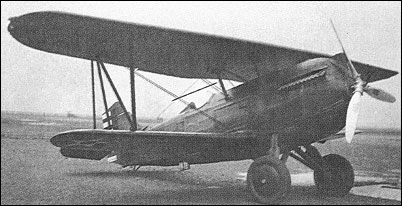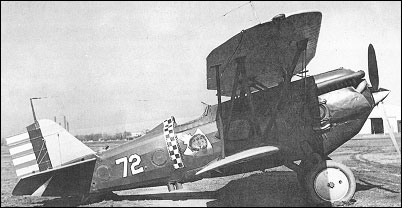|
| Installation of the new 600hp Curtiss V-1570-1 Conqueror
engine in a P-2 airframe for participation in the
September 1927 air races at Spokane led to the application
of the designation XP-6. A similarly-powered aircraft
utilising a P-1A fuselage, XPW-8A wings and surface
radiators became the XP-6A. A third
Conqueror-powered conversion of a P-1C airframe for a
New York-Alaska flight, in July 1929, was assigned the designation XP-6B. Although these aircraft were intended
purely to prove the Conqueror engine, the success
of this power plant prompted a USAAC order for 18
P-6s on 3 October 1928, these being powered by the
600hp water-cooled V-1570-17. Although generally
similar to the P-1 in construction, they embodied extensively
revised fuselage contours. Deliveries commenced
in October 1929, but with the 11th aircraft Prestone
(ethylene glycol) cooling was introduced, the designation changing to P-6A. The V-1570-23 engine in
the P-6A had a similar rating to that of the -17 that it
supplanted; armament remained unchanged at two
7.62mm guns. In service, eight of the Army Air
Corps P-6s were brought up to P-6A standards. Eight
additional P-6s were delivered to the Netherlands East
Indies and one to Japan under the export designation
Hawk I. Subsequent to being converted as a P-6A, the
first production P-6 was fitted with a side-mounted
turbo-supercharger on its V-1570-23 engine as the
XP-6D, and, in 1932, 10 P-6As were fitted with F-2F
superchargers as P-6Ds. In addition, two aircraft
originally ordered as P-11s (P-6 airframes with the unsatisfactory
600hp Curtiss H-1640 Chieftain engine)
were completed as P-6Ds. The P-6D was 122kg
heavier than the P-6A and featured a three-bladed propeller,
and its performance included max speeds of
306km/h at 3050m and 317km/h at 3960m, service ceiling being
9755m.
 | A three-view drawing of P-6E (1280 x 912) |
| MODEL | P-6A |
| WEIGHTS |
| Take-off weight | 1439 kg | 3172 lb |
| Empty weight | 1083 kg | 2388 lb |
| DIMENSIONS |
| Wingspan | 9.60 m | 32 ft 6 in |
| Length | 7.19 m | 24 ft 7 in |
| Height | 2.62 m | 9 ft 7 in |
| Wing area | 23.41 m2 | 251.98 sq ft |
| PERFORMANCE |
| Max. speed | 286 km/h | 178 mph |
| Richard, e-mail, 04.08.2015 20:56 Where could I locate P-6E propeller stencil data (DWG. NO., Blade Angle, A.C. No., etc.)
Thanksmuch,
Richard reply |
|
Do you have any comments?
|
| 
COMPANY
PROFILE
All the World's Rotorcraft
|









